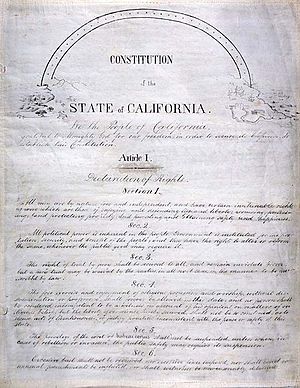California Constitutional Conventions facts for kids
The California Constitutional Conventions were important meetings held in California during the 1800s. These meetings helped create the rules and laws for the state, which are found in the Constitution of California. Think of a constitution as a rulebook for how a government should work.
The first meeting, called the Monterey Convention, happened in 1849. This was before California officially became a U.S. state. At this convention, they wrote the state's first constitution. This original rulebook is still important today, even though a newer one was made later.
The second big meeting was the Sacramento Convention, which took place from 1878 to 1879. This convention created the current California Constitution, which was approved on May 7, 1879. This new constitution was very detailed. Some people even said it was too long and complicated!
People have talked about having a third convention in recent years. However, these ideas haven't gathered enough support to happen yet.
Contents
The First Big Meeting: Monterey (1849)

The Monterey Convention in 1849 was California's very first meeting to write a constitution. The person in charge of California at the time, General Bennett C. Riley, announced the meeting on June 3, 1849. He also called for a special election on August 1 to choose the people who would attend the convention. These people were called "delegates."
When the delegates presented their new constitution to the U.S. Congress, they explained some of their decisions. For example, they said that slavery was not allowed in California. They agreed on this because they felt California's land and weather were not good for slave labor.
They also decided on California's eastern border. Some people wanted California to include a much larger area, like parts of today's Nevada, Utah, and Arizona. But they settled on a compromise. This border included the western part of Nevada but left out some other areas. The delegates also said they never considered splitting California into northern and southern parts.
The Second Big Meeting: Sacramento (1878–79)
The Sacramento Convention took place in Sacramento, California. It lasted for a whole year, from March 1878 to March 1879. The main goal of this meeting was to change and update the original 1849 constitution.
There were 152 delegates at this convention. These delegates were chosen in different ways. Some were elected from specific areas called districts. Other delegates were elected by people from the entire state. Each of California's four Congressional districts also elected eight delegates.
After a lot of work, the new California Constitution was finished. People voted on it on May 7, 1879. It was approved with 77,959 votes in favor and 67,134 votes against it.
What About Future Conventions?
The California Constitution has rules about how to call another convention to change or update it. It says that the state's lawmakers (the Legislature) can vote to ask the public if they want a convention. If two-thirds of the lawmakers agree, the question goes on the ballot during a general election.
If most people vote "yes" to have a convention, then the Legislature must plan for it within six months. The people who attend this convention (the delegates) would be voters elected from different areas, making sure each area has about the same number of people.
In 2010, there were ideas for new ways to call a convention. Some proposals suggested that citizens could be delegates. For example, one idea was to have 240 delegates from Assembly districts. These delegates would be chosen from a group of randomly selected people. Another idea was to have delegates from each county and even from federally recognized Native American tribes. The goal was to have many different voices involved in making changes to the constitution.
See also
 In Spanish: Convenciones constitucionales en el estado de California para niños
In Spanish: Convenciones constitucionales en el estado de California para niños


